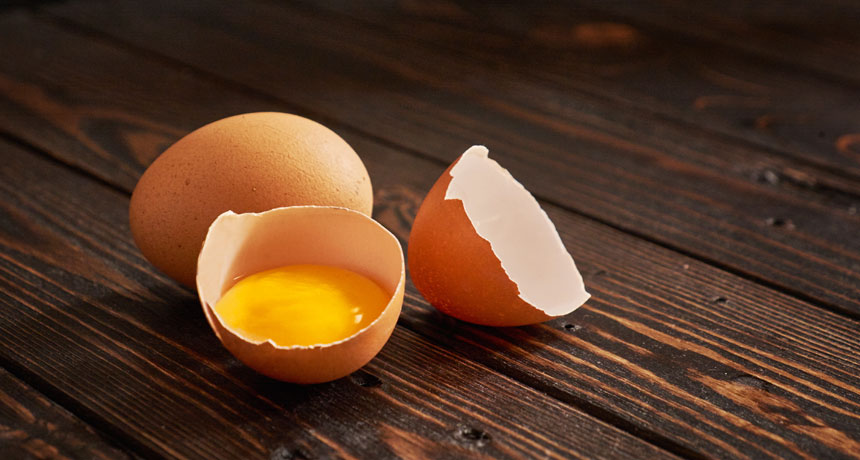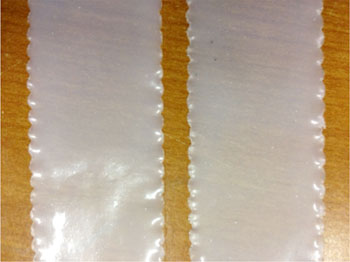Eggshells help hatch a new idea for packaging
Nano bits of eggshells let two biodegradable plastics work better together.

Teeny, tiny bits of eggshells might soon be part of biodegradable plastic cartons to hold more eggs.
V_ace/iStock Photo
An old proverb says you’ve got to crack a few eggs to make an omelet. Most people then toss those eggshells out. Indeed, a lot of eggshells end up in landfills, observes Boniface Tiimob. He’s a materials scientist and graduate student at Tuskegee University in Alabama. But now, he says, there’s a promising new use for that waste. Those shells can be recycled into packaging for more eggs or other goods.
Vijaya Rangari is a materials scientist, also at Tuskegee. He and Tiimob got their idea when the National Science Foundation challenged researchers to find ways to put wastes to good use. The team even decided to make its new packaging biodegradable. In other words, they designed it to break down into safe materials over a fairly short period. Then nature can recycle those breakdown products into new resources.

One earlier study combined calcium carbonate with PLA. This allowed the plastic to flex a bit more before it broke. Another study showed that PLA was also more flexible with some PBAT added to it. But the two plastics generally don’t mix well, Rangari notes.
He and Tiimob believed they could build upon those studies. They reasoned that calcium carbonate could help the polymers blend, at the same time adding flexibility. Eggshells, as they are mostly calcium carbonate, could be a good source, Rangari and Tiimob figured. So they mixed bits of eggshell in with the plastics. Tiny bits.
The researchers chose nano-scale particles because they would have lots of surface area. Rangari’s group had already figured out how to make the nanoparticles. First, they ground clean eggshells into a fine powder. That process was a lot like grinding wheat into flour. Next, they blasted the fine powder with ultrasonic waves. These are energy waves that have a frequency higher than audible sound. The force broke the powder down even further into teeny, tiny bits. Each was shaped like a stacked deck of cards and was 10 nanometers across. (A human hair is more than 350,000 times as thick.)
The team blended the eggshell nanoparticles into various mixtures of PLA and PBAT. The best performance came from a mix that was about 0.5 percent eggshell. The rest of it was seven parts of PBAT to every three parts of PLA. The result was about seven times more flexible than other biodegradable polymer blends, Rangari said. The plastic was also strong enough for most packaging uses.
The researchers described their work on March 16 in San Diego at the spring national meeting of the American Chemical Society.
What’s next?
The team is now looking into what happens to the eggshell-plastic blend in soil. They especially want to see how the calcium carbonate interacts with plants, Tiimob says. The carbonate should improve the soil and lower its acidity. The calcium should help tomatoes and some other plants that need a lot of that nutrient as their fruit grows.
The scientists are even working on possible medical uses for eggshell nanoparticles. For example, they might make better dental fillings or help heal bone injuries, Rangari says.
Jinwen Zhang is a materials scientist at Washington State University in Pullman. He has worked with PBAT, PLA and calcium carbonate. Zhang thinks the Tuskegee team’s idea of using eggshell nanoparticles could prove very useful.
“The group should be commended for thinking to utilize the eggshell,” says Zhang. “This way, you turn waste into something that may be useful.”
But making a good, biodegradable plastic is only half the challenge, says Susan Selke. She is a chemical and packaging engineer at Michigan State University, in East Lansing, and not involved with the new plastic. The biodegradable plastic must still get to a compost system, she says. By that she means there should be a way for people to separate it and certain food wastes from other types of trash. Then these materials should go to a place where microbes will have enough oxygen and moisture to break them down.
“If these [plastics] are going to go to a composting system, then being biodegradable makes sense,” Selke says. “If they are going to go to a landfill, it doesn’t make sense,” because they’ll get little chance to degrade. The plastic has to be designed for how it will be used — and disposed of.
Power Words
(for more about Power Words, click here)
antibacterial Having properties that tend to destroy or limit the growth or reproduction of bacteria.
audible Something that can be heard, usually with ears or other sound-sensing structures.
biodegrade To break down, based on the activity of microbes, into simpler materials. This usually occurs in the presence of water, sunlight or other conditions that help nurture those organisms.
calcium carbonate The main chemical compound in limestone, a rock made from the tiny shells of ancient marine organisms. Its formula is CaCO3 (meaning it contains one calcium atom, one carbon atom and three oxygen atoms). It’s also the active ingredient in some antacid medicines (ones used to neutralize stomach acids).
chemical engineer A researcher who uses chemistry to solve problems related to the production of food, fuel, medicines and many other products.
compost The end product in the breakdown, or decomposition, of leaves, plants, vegetables, manure and other once-living material. Compost is used to enrich garden soil, and earthworms sometimes aid this process.
degrade (in chemistry) To break down a compound into smaller components.
engineer A person who uses science to solve problems. As a verb, to engineer means to design a device, material or process that will solve some problem or unmet need.
frequency The number of times a specified periodic phenomenon occurs within a specified time interval. (In physics) The number of wavelengths that occurs over a particular interval of time.
graduate student Someone working toward an advanced degree by taking classes and performing research. This work is done after the student has already graduated from college (usually with a four-year degree).
landfill A site where trash is dumped and then covered with dirt to reduce smells. If they are not lined with impermeable materials, rains washing through these waste sites can leach out toxic materials and carry them downstream or into groundwater. Because trash in these facilities is covered by dirt, the wastes do not get ready access to sunlight and microbes to aid in their breakdown. As a result, even newspaper sent to landfill may resist breakdown for many decades.
materials science The study of how the atomic and molecular structure of a material is related to its overall properties. Materials scientists can design new materials or analyze existing ones. Their analyses of a material’s overall properties (such as density, strength and melting point) can help engineers and other researchers select materials that best suited to a new application.
molecule An electrically neutral group of atoms that represents the smallest possible amount of a chemical compound. Molecules can be made of single types of atoms or of different types. For example, the oxygen in the air is made of two oxygen atoms (O2), but water is made of two hydrogen atoms and one oxygen atom (H2O).
nano– A prefix indicating a billionth. In the metric system of measurements, it’s often used as an abbreviation to refer to objects that are a billionth of a meter long or in diameter.
nanotechnology Science, technology and engineering that deals with things and phenomena at the scale of 100 billionths of a meter or less.
particle A minute amount of something.
plastic Any of a series of materials that are easily deformable; or synthetic materials that have been made from polymers (long strings of some building-block molecule) that tend to be lightweight, inexpensive and resistant to degradation.
polylactic acid (abbreviated PLA) A plastic made by chemically linking long chains of lactic-acid molecules. Lactic acid is a substance present naturally in cow’s milk.
polymer Substances whose molecules are made of long chains of repeating groups of atoms. Manufactured polymers include nylon, polyvinyl chloride (better known as PVC) and many types of plastics. Natural polymers include rubber, silk and cellulose (found in plants and used to make paper, for example).
recycle To find new uses for something — or parts of something — that might otherwise be discarded, or treated as waste.
surface area The area of some material’s surface. In general, smaller materials and ones with rougher or more convoluted surfaces have a greater exterior surface area — per unit mass — than larger items or ones with smoother exteriors. That becomes important when chemical, biological or physical processes occur on a surface.
ultrasound Sounds at frequencies above the range that can be detected by the human ear. (adj. ultrasonic).
This is one in a series presenting news on technology and innovation, made possible with generous support from the Lemelson Foundation.







